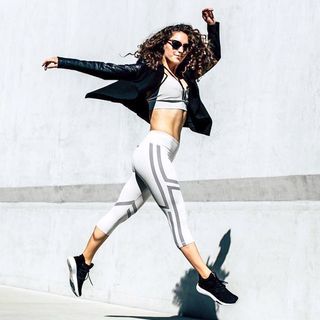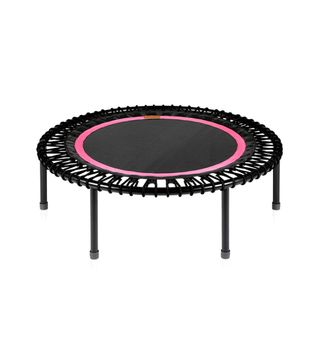Calling It: This Will Be the Most Talked-About Workout in 2018


I was still airborne in my first trampoline class last fall when the thought first crossed my mind: This workout is about to be everywhere. I was drenched in sweat, my muscles ached, and I struggled to catch my breath—usually a lethal combination for a hopeless cardio-phobe like me. And yet I was having the time of my life. Within minutes of arriving home, I was already perusing Amazon for a mini trampoline of my own.
For those of us who still associate trampolines with the covetable backyard variety of our childhoods, the concept of rebounding as an organized workout might be a little foreign. In reality, most rebounding workouts are an amalgamation of that care-free nostalgia and dance cardio or HIIT workouts—think high knees and butt kicks with a much more forgiving sense of gravity.
"We gravitate toward things that are fun and rebounding definitely falls into that category," says Kara Griffin, an L.A.-based trainer and holistic nutritionist. "Jumping can bring us back to an activity that we most likely did as a child, but besides being fun, it also touts a lot of benefits."
That's why rebounding studios are beginning to crop up across the country: Bari's Bounce classes are wildly popular, while Lauren Kleban's LEKfit has also swept headlines as a celeb-loved fitness destination. The other option is to bring the workout into your own home, and I can't help but wonder if the trampoline will be the new treadmill in this regard: Bellicon's rebounders are an industry fave, and Amazon offers a variety of mini trampolines to fit many different budgets.
But it's definitely worth versing yourself on the amazing benefits of rebounding before hitting a class or investing in a trampoline of your own.
Defying gravity allows you to focus your attention elsewhere.
How different would your favorite workout feel if you took gravity and impact out of the equation? "Imagine doing one minute of high knees on the ground at your typical HIIT class… woof," says Griffin. "That same movement on the trampoline is a run, and while challenging (it's still a run), it feels incredible. There's no hip, knee, or ankle pain, and instead, you feel your abs engaging."
Less pain, more gain.
"Rebounding is about 40% less impact than if you were to do the same movements on the floor or ground," says Griffin. "The cords of a rebounder absorb the landing shock in the joints and instead recruit the leg muscles and core to stabilize you."
In other words, the flip side of bouncing is that there's an added element of balance: Your joints feel better, but your body is also working hard to stay upright and in control. "Because you're not working your joints as much, you're able to tone and strengthen your muscles while getting a cardio workout," says Griffin. "My clients always report feeling worked from the lower core down as they're getting their heart rate up. Since your body has to work harder to balance on such a dynamic platform, you're using both slow and fast-twitch muscle fibers to keep you in the movements."
There's science to back that up. Griffin cites a 2016 study that found that rebounding is "twice as effective at improving aerobic fitness and 50% more efficient at burning fat than running." That's thanks to the perfect storm of elements we covered here: Bouncing forces us to engage in more dynamic movement and stabilization while also keeping our heart rates elevated.
The other bonus: Without the additional load of gravity and impact on your joints, you feel like you can work harder for longer.
Bouncing encourages fluid movement and stimulates the body's detoxification process.
"When you bounce and move from weightlessness to below your center of gravity, you're detoxifying your body—yes, through the skin via your sweat-inducing workout, but also through your lymphatic system," says Griffin. "The jumping is essentially shaking up any toxins that are being held in the lymph tissue, allowing for it to leave a stagnant place and hopefully be processed out." Think of it as an active form of lymphatic drainage.
Over time, you'll become more spatially aware—both on and off the trampoline.
Our natural inclination is to look and move forward, and rebounding challenges that. "Because you're bouncing up and down (a movement we don't usually do in everyday life) and you're on an elevated surface, you're testing your proprioception," says Griffin. "Proprioception is the sense of your physical body in space, and it helps your body work in a 3D functional way rather than in a forward motion, which tends to be our default."
Rebounders are more versatile than you think.
It's not just about bouncing. Griffin sees her rebounder as a do-it-all piece of equipment: a trampoline, a balance board, a barre, and a plyometric bench.
"This one piece of equipment can give you an entire cardio and toning workout," she says. "In my mind, equipment minimalism is always another way to stay focused in your workouts: keep it simple, keep it effective."
It bears repeating: It's so much fun.
Combine the endorphins with that nostalgic thrill, and you'll have a recipe for a serious mood boost. The physical benefits might be pretty incredible, but our guess is that this feeling alone will be enough to bring you back for more.
RELATED VIDEO
Disclaimer
This article is provided for informational purposes only and is not intended to be used in the place of advice of your physician or other medical professionals. You should always consult with your doctor or healthcare provider first with any health-related questions.


